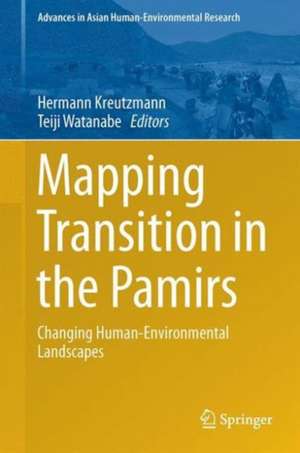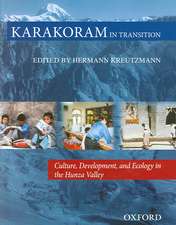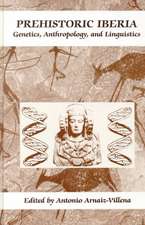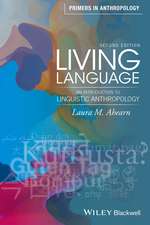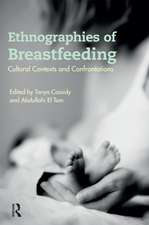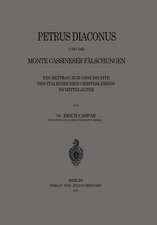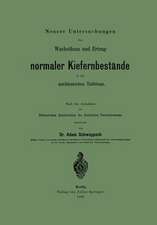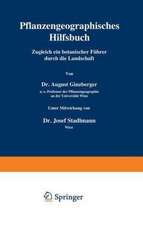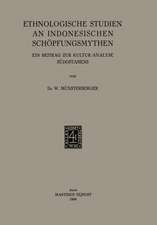Mapping Transition in the Pamirs: Changing Human-Environmental Landscapes: Advances in Asian Human-Environmental Research
Editat de Hermann Kreutzmann, Teiji Watanabeen Limba Engleză Hardback – feb 2016
| Toate formatele și edițiile | Preț | Express |
|---|---|---|
| Paperback (1) | 559.01 lei 38-44 zile | |
| Springer International Publishing – 31 mar 2018 | 559.01 lei 38-44 zile | |
| Hardback (1) | 578.30 lei 38-44 zile | |
| Springer International Publishing – feb 2016 | 578.30 lei 38-44 zile |
Din seria Advances in Asian Human-Environmental Research
- 18%
 Preț: 956.81 lei
Preț: 956.81 lei - 20%
 Preț: 560.01 lei
Preț: 560.01 lei - 18%
 Preț: 890.54 lei
Preț: 890.54 lei - 18%
 Preț: 788.72 lei
Preț: 788.72 lei - 15%
 Preț: 645.47 lei
Preț: 645.47 lei - 24%
 Preț: 725.19 lei
Preț: 725.19 lei - 18%
 Preț: 948.16 lei
Preț: 948.16 lei - 18%
 Preț: 787.78 lei
Preț: 787.78 lei - 15%
 Preț: 640.37 lei
Preț: 640.37 lei - 15%
 Preț: 646.43 lei
Preț: 646.43 lei - 15%
 Preț: 665.58 lei
Preț: 665.58 lei - 18%
 Preț: 948.16 lei
Preț: 948.16 lei - 15%
 Preț: 635.31 lei
Preț: 635.31 lei - 15%
 Preț: 647.73 lei
Preț: 647.73 lei - 18%
 Preț: 1029.13 lei
Preț: 1029.13 lei - 15%
 Preț: 640.06 lei
Preț: 640.06 lei - 18%
 Preț: 950.52 lei
Preț: 950.52 lei - 18%
 Preț: 1575.88 lei
Preț: 1575.88 lei - 15%
 Preț: 642.18 lei
Preț: 642.18 lei - 18%
 Preț: 896.08 lei
Preț: 896.08 lei - 15%
 Preț: 639.41 lei
Preț: 639.41 lei - 15%
 Preț: 645.28 lei
Preț: 645.28 lei - 15%
 Preț: 641.03 lei
Preț: 641.03 lei - 18%
 Preț: 954.62 lei
Preț: 954.62 lei - 15%
 Preț: 642.51 lei
Preț: 642.51 lei - 15%
 Preț: 644.95 lei
Preț: 644.95 lei - 18%
 Preț: 1023.74 lei
Preț: 1023.74 lei - 18%
 Preț: 954.31 lei
Preț: 954.31 lei - 15%
 Preț: 640.55 lei
Preț: 640.55 lei - 15%
 Preț: 644.18 lei
Preț: 644.18 lei - 15%
 Preț: 641.71 lei
Preț: 641.71 lei - 18%
 Preț: 938.21 lei
Preț: 938.21 lei - 15%
 Preț: 644.18 lei
Preț: 644.18 lei
Preț: 578.30 lei
Preț vechi: 722.87 lei
-20% Nou
Puncte Express: 867
Preț estimativ în valută:
110.69€ • 120.28$ • 93.04£
110.69€ • 120.28$ • 93.04£
Carte tipărită la comandă
Livrare economică 17-23 aprilie
Preluare comenzi: 021 569.72.76
Specificații
ISBN-13: 9783319231976
ISBN-10: 3319231979
Pagini: 220
Ilustrații: XV, 274 p. 100 illus., 80 illus. in color.
Dimensiuni: 155 x 235 x 21 mm
Greutate: 0.7 kg
Ediția:1st ed. 2016
Editura: Springer International Publishing
Colecția Springer
Seria Advances in Asian Human-Environmental Research
Locul publicării:Cham, Switzerland
ISBN-10: 3319231979
Pagini: 220
Ilustrații: XV, 274 p. 100 illus., 80 illus. in color.
Dimensiuni: 155 x 235 x 21 mm
Greutate: 0.7 kg
Ediția:1st ed. 2016
Editura: Springer International Publishing
Colecția Springer
Seria Advances in Asian Human-Environmental Research
Locul publicării:Cham, Switzerland
Public țintă
ResearchCuprins
1. Pamirian Spaces – Mapping Process Geographies in the Mountainous Periphery.- 2. Pamir or Pamirs – Perceptions and Interpretations.- 3. Who is mapping the Pamirs? A Review on Plant and Vegetation Sciences.- 4. Geomorphic Features of the Eastern Pamirs, with a Focus on the Occurrence of Intermontane Basins.- 5. Water of the Pamir – Potential and Constraints.- 6. Khans, Kings, Communists, Warlords, and Presidents: Afghan Kirghiz Socio-economic Strategies for Extorting and Extracting from the State.- 7. Changes in the Relationship between Borders and Pastoral Mobility in Mountain Regions of Central Asia.- 8. Seasonal Pasture Use and Vegetation Cover Changes in the Alai Valley, Kyrgyzstan.- 9. Diversity of Seasonal Migration of Livestock in the Eastern Alai Valley, Southern Kyrgyzstan.- 10. Kezüü and Novad: A Form of Pastoralism in the Eastern Alai Valley, Southern Kyrgyzstan.- 11. External Support and Local Agency: Uncertain Transformations of Livelihoods in the Pamirian Borderland of Tajikistan.- 12. The Current Status of Lifestyle and Occupations in the Wakhan Area of Tajikistan.- 13. Political Ecology of Human-Environmental Change in Gojal, Gilgit-Baltistan, Pakistan.- 14. The Changes in Regional Structure and Land Use related to External Factors in Hussaini Village, Northern Pakistan.- 15. Humanitarianism across Mountain Valleys: “Shia Aid” and Development Encounters in Northern Pakistan and Eastern Tajikistan.- 16. History of the Development of the Pamir Region of Tajikistan (Gorno-Badakhshan).- 17. Conclusions: Why do we need to make Efforts to Map the Transition?
Notă biografică
Prof. Hermann Kreutzmann has been a professor of human geography at Freie Universität Berlin since April 2005. He had previously completed his doctorate at the Department of Earth Sciences at Freie Universität Berlin in 1989. Kreutzmann’s research focuses on geographical development studies. He conducts his research mainly in high mountain areas, especially in South and Central Asia, in the context of globalization and climate change debates. His research also focuses on sustainable resource use as well as minority studies and migration research.
Hermann Kreutzmann is a recipient of the Tianshan Prize China from the Xinjiang Uyghur Autonomous Region. He received the award for his “outstanding contribution to the economic and social progress” of this region located in northwest China. For more than 25 years Kreutzmann has been conducting research there on issues of resource use and the development of mountain regions. In addition, he was honored for his contribution to scientific cooperation and his support of German-Chinese cooperation in the education of young scientists. This award is the highest that can be awarded to a foreign expert in Xinjiang.
Hermann Kreutzmann is a recipient of the Tianshan Prize China from the Xinjiang Uyghur Autonomous Region. He received the award for his “outstanding contribution to the economic and social progress” of this region located in northwest China. For more than 25 years Kreutzmann has been conducting research there on issues of resource use and the development of mountain regions. In addition, he was honored for his contribution to scientific cooperation and his support of German-Chinese cooperation in the education of young scientists. This award is the highest that can be awarded to a foreign expert in Xinjiang.
Textul de pe ultima copertă
By emphasizing on the Pamir region a comprehensive overviewof path-dependent and recent developments in a remote mountain region isprovided in this book. Overall neglect in the mountainous periphery iscontrasted by shifting the centre of attention to the Pamirssituated at the interface between South and Central Asia. From colonialtimes to now there has been a debate on grasping and locating the area. Herefield-work based contributions are collected to provide a variety ofperspectives on the Pamirs highlighting transformation and transition inPost-Soviet societies as well as in Afghanistan and Pakistan. The similarecological environment across borders features the common groundwhile analyzing development processes in a set of case studies that aim athighlighting certain aspects of regional development.
Caracteristici
Provides evidence from recent empirical research A comprehensive overview of a neglected mountain region in the interface between South and Central Asia Analyzes development processes in a set of case studies
